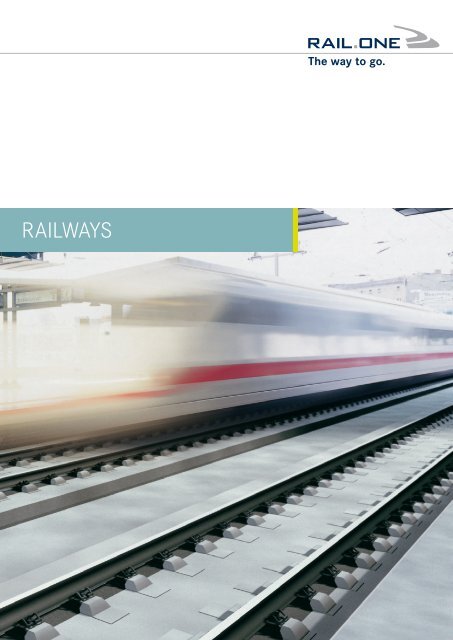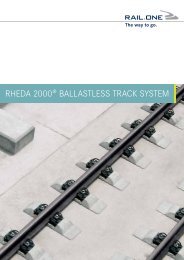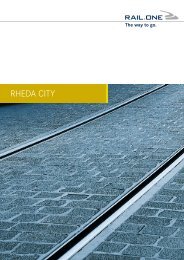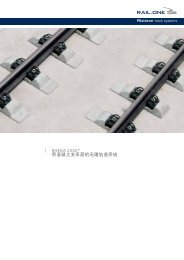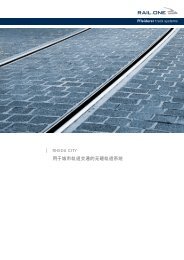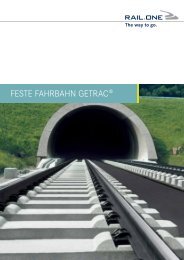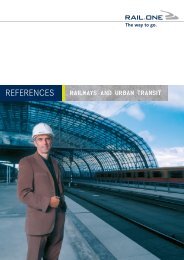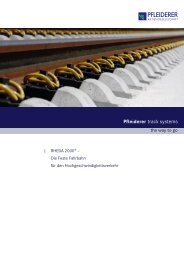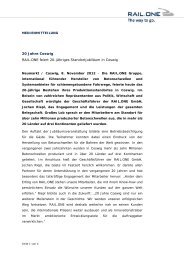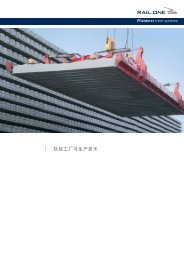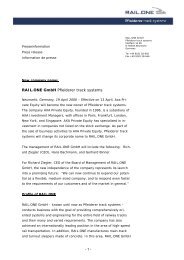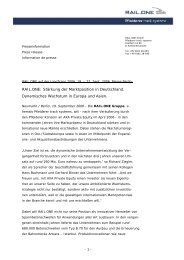RAILwAyS - RAIL.ONE GmbH
RAILwAyS - RAIL.ONE GmbH
RAILwAyS - RAIL.ONE GmbH
You also want an ePaper? Increase the reach of your titles
YUMPU automatically turns print PDFs into web optimized ePapers that Google loves.
RailwaysThe way to go.
Railways<strong>RAIL</strong>.<strong>ONE</strong> – the way to goWe develop innovative track systems, to help you get ahead –fast and safely. And what are your plans?Your objective is our challenge<strong>RAIL</strong>.<strong>ONE</strong> delivers innovative track systems for railway transportin Germany and around the world: we offer engineering,production, supply, logistics, and quality management – allon a one-stop basis. Our systems require very little maintenanceover the course of time and allow stable track geometryand excellent ride comfort, even at high speeds and underextremely rigorous conditions. And since every track shouldbe optimized for its individual operational area, <strong>RAIL</strong>.<strong>ONE</strong>places special emphasis on close collaboration with customersand business partners. With its extensive sales network– as well as locations in Germany, Europe, America, and Asia– <strong>RAIL</strong>.<strong>ONE</strong> occupies a leading position in track-system technologyand in the manufacturing of concrete sleepers. Continuousresearch and further development assure our technologicallead.<strong>RAIL</strong>.<strong>ONE</strong> – development based on experience<strong>RAIL</strong>.<strong>ONE</strong> has become well established as a comprehensivelyoriented systems and engineering provider for the entire fieldof railway track, with its great number and diversity of requirements.In the high-speed area, the company has achieved aninternationally leading position. <strong>RAIL</strong>.<strong>ONE</strong> furthermore offersthe production of concrete main-track and turnout sleepers.All of this means that <strong>RAIL</strong>.<strong>ONE</strong>, in close cooperation with customersand business partners, performs complete services forproduct development, manufacture, and application on a onestopbasis – beginning with engineering; including production,supply, and logistics; and extending to quality management.
RailwaysWe are readyTrack systems represent the future way to go. But markets are changing,and new concepts are in urgent demand. The first step involvescommunication – so let’s talk about what you need.On the right trackWhen it comes to economy, reliability, and environmental compatibility,railways are miles ahead of their competitors on thehighways, on water, and in the air. And even as far as speedis concerned, air travel over short and medium distances canhardly compete now with the new offerings in European railtransport. Road transportation has long since reached the limitsof its capacity – despite ongoing high investment. Especiallywith a view to European cargo transport of the future,railways obviously offer the only escape. Europe, after all,presents promising chances: unification in the EU has openedup completely new possibilities for cross-border rail-infrastructureconstruction and joint development projects for passengerand cargo transportation.With new concepts toward new horizonsA revolution in railway culture was necessary to move it successfullyinto the future. Harmonization of technical standardsand new forms of awarding contracts have quickly led to newquality in customer-provider relationships. Communicationsplays a key role here – and this is where <strong>RAIL</strong>.<strong>ONE</strong> comes intoaction. Track systems and infrastructure must now as before– and, in the future, even more extensively – be designed foradvanced transportation systems. And a great deal remains tobe done: e.g., transportation networks are still not fully compatibleat borders between countries. Research for innovativeproducts and manufacturing techniques must be continuouslyand vigorously promoted. Planning and implementation workmust be more effectively focussed and coordinated. The keyto successful project work lies in the integration of the systemprovider into the engineering and construction processes.
We have grasped what is requiredAs systems provider, <strong>RAIL</strong>.<strong>ONE</strong> occupies the interface betweenplanners, general contractors, and construction companies.A complex construction project – such as the new highspeedlines from Nuremberg to Ingolstadt, from Amsterdam toBrussels (HSL Zuid), and from Taipei to Kaohsiung in Taiwan –demands far more than mere delivery of hardware. <strong>RAIL</strong>.<strong>ONE</strong>accordingly understands its mission as a service and competenceprovider. Leadership in technology is assured not onlythrough advanced production facilities and innovative processtechnology, but primarily through experience and know-howin engineering. The strict quality criteria of railway authoritiesplay a key role here – and with respect to safety, innovation,reliability, profitability, aesthetics, comfort, and environmentalfriendliness, <strong>RAIL</strong>.<strong>ONE</strong> is ready indeed for the rail marketof the future.
RailwaysYour capable partnerComplex projects demand clarity in control. After all: rail transport involvesgreat responsibility. As system providers, we are well accustomed to workingsystematically. Try us and see!EngineeringWhen the ground is broken for a construction project, half thework is already finished. The more predictive the planning, ofcourse, the less problematic the actual execution. <strong>RAIL</strong>.<strong>ONE</strong>provides engineering services to construction companies asearly as the bid-invitation and tendering phase. A complete detaildesign is the basis for all following steps – which enablesprecise calculation of costs. From rough to detail planning,<strong>RAIL</strong>.<strong>ONE</strong> is actively integrated into the design process. Thetrack system is modified if necessary, collaboration betweenthe partner companies is coordinated, the site is examined,materials tests are conducted, and the logistics concepts andinstallation processes are tailored to the specific project.Production – Supply – Logistics<strong>RAIL</strong>.<strong>ONE</strong> profits from more than 50 years of experience in themanufacture of concrete sleepers. Supply of complete tracksystems, however, demands far more: the entire process chain– starting with planning; including production, delivery, and logistics;and extending to quality management – must be holisticallyunderstood and effectively supported. For example,it can be advisable from logistics or cost-effectiveness standpointsto set up a sleeper production plant near the track constructionsite – or to award manufacturer’s licenses to localpartner companies. <strong>RAIL</strong>.<strong>ONE</strong> remains responsible for the coordination:because effective supervision makes sure that everythingproperly rolls.
Quality ManagementSafety of course enjoys absolute top priority, especially wherepassenger transport is involved. <strong>RAIL</strong>.<strong>ONE</strong> provides the entireperformance spectrum – from supervision to quality management– in its work with owners, operators, and partners.Integrated process management assures that the installedsystems satisfy the required quality criteria in all stages of productionand installation. Although it is precisely ballastlesstrack systems that have proven extensively maintenance-free,<strong>RAIL</strong>.<strong>ONE</strong> together with customers and partners develops conceptsfor long-term quality assurance. In addition, a RAMSanalysis was successfully conducted, in accordance with internationalstandards for the RHEDA 2000® ballastless.From planning to quality assurance: the entire spectrumof services from one source.
RailwaysSystematically toward successWhich track system is the best for you? Sometimes, a simple application will solveyour problem faster – but sometimes a sophisticated solution actually representsthe simplest alternative. Whatever, we’ll help you find the best way.Many roads lead to RomeEvery new project poses new challenges for engineers andplanners. With respect to long service life, top speed, comfort,and load-carrying capability, ballastless track basicallyhas a lot to speak for it – especially in the construction of newrail lines. Where refurbishment of existing lines is involved,however, a system that allows traffic to continue, even duringconstruction, offers key benefits. In many applications, conventionalballasted tracks fully satisfy all requirements. Widesleepers on a ballast substructure can offer significant benefitswhere availability is crucial. Life-cycle costs have also becomeincreasingly important in planning a track route. It is essentialto consider whether a virtually maintenance-free trackis the most favourable long-term solution, or whether thechoice should go to a system that can be installed on a flexibleand cost-reducing basis, without traffic interruption.From the environmental standpointAs future-oriented means of transport, rail systems are eminentlycapable of fulfilling their responsibilities to the environment.Where strict limit values for airborne noise and vibrationapply, especially in densely populated areas, innovativemass-spring systems and noise-absorbing products assuregood neighbourliness. Increasingly, aesthetic criteria are appliedto track systems, particularly in urban environments.Parasitic current must be dissipated below stipulated limits,and intelligent disposal of waste water and other liquids mustbe guaranteed. <strong>RAIL</strong>.<strong>ONE</strong> places great importance on theseproblems. Careful selection of the solution consequently determinesthe service and maintenance expenses of a tracksystem: foresight in planning eventually amounts to considerablemoney savings.The route follows the terrain, and not vice-versaA track system by <strong>RAIL</strong>.<strong>ONE</strong> is always a tailored solution, especiallyin which systems must be adapted to special requirements.Certain track sections such as curves, bridges, embankments,tunnels, and turnouts place strict requirementson route design. The characteristics of the subgrade have decisiveconsequences for planning: What physical forces andenvironmental influences can be expected? How will the soilreact to operational loads over the long run? And – what logisticsrequirements must be considered during construction? Afterall: optimization of the process chain is our primary goal,and this includes construction-site access, transport paths,and material supply.
All systems at a glanceWhen requirements go beyond conventional ballasted systems,<strong>RAIL</strong>.<strong>ONE</strong> has the appropriate solution for all demands ofrailway transportation. Besides to operating speed and axleload, many additional factors are essential in selection ofrail systems. Among these factors, long-term availability andmaintenance costs play increasingly significant roles.HEAVY-HAUL TRANSPORT500250Standard ballasted track systemSpecial ballasted track systemAxle load in kN200<strong>RAIL</strong>WAYSTrunk linesURBAN TRAnsitCommuter systemsHigh-speed trafficRHEDA 2000® ballastless track systemGETRAC® ballastless track systemRHEDA CITY ballastless track system150TramsUndergroundRHEDA MRT ballastless track systemThe Green Tracks (ATD-G and RHEDA CITY GREEN)10040 100 200 300Speed in km/h
Railways1011Our classical track:simple and flexibleNow as before, concrete sleepers on ballast represent the classical, fundamentalversion of track systems: in Germany and around the world. The general opinionis that these sleepers could not possibly be improved: but we’re working on it.Type B 70 concrete sleepers are the simplest way to acomplete railway track. Their chief advantage is their greatflexibility. These sleepers are a fast and reliable solution for almostany application: whether for a newly constructed route orfor refurbishment of existing lines, for railways or urban transit,for trunk or secondary lines, and for freight or passenger traffic.And their simple installation ensures high availability levels.The B 70 concrete sleeper can also be manufactured and deliveredin great numbers within a very short period of time. In Germany,<strong>RAIL</strong>.<strong>ONE</strong> delivers annually up to one million concretemain-track sleepers, primarily Type B 70. Every year, the companyproduces approximately 1.5 million sleepers in Romania,Saudi Arabia, Spain, South Korea, Turkey, and Hungary, primarilyin the models favoured for use in the respective countries.Also for turnouts, concrete sleepers have become widelyand successfully accepted. Their economic and technical advantagesare the results of longer life cycles, less maintenance,and mechanized installation techniques. Production of thesesleepers in several plants, with capacity of up to 680,000 linearmetres annually, takes place in close technical and logisticalcoordination with the manufacturers of the turnouts with whichthey will be installed. Only in this way is it possible to guaranteeon-time support of track construction sites at the superiorquality levels characteristic of <strong>RAIL</strong>.<strong>ONE</strong>.The B 70 concrete sleeper: a clear-cut solutionHighly convenient and cost-effective production and installation,long service life, and no impregnation with toxic agents: all thismakes the concrete sleeper an environmentally friendly andcost-effective solution over the long run.Turnout sleepers: sturdy and safe With their greatweight, concrete turnout sleepers assure optimal track-positionpermanence and stability – even for turnouts that take traffic athigh speed.
CONCRETE SLEEPER B 70High performance capability, even under conditions of great operational loadsCost-effective optimization of the track system, together with full maintenance of long-termtechnical and safety characteristicsGuarantee of operational continuityStandardization of operational and maintenance work sequencesPossibility of fully mechanical installation of sleepers on the building siteAdaptation of track elasticity to special sub-base conditions by installation of elastic pads
Railways1213Wider, faster: more sophisticatedWide-sleeper track systems combine the benefits of ballastless track withconventional ballasted systems. As a result, this sleeper system satisfies the mostdemanding of requirements – and it manages to look good at the same time.Wide sleepers are used in regional and mainline railwayapplications. The system is suitable for all gauges, for tiltingtechnology, and for either freight or passenger traffic. As a resultof its appealing design and ease of maintenance for itssurface, it is also well suited for tracks in train stations. Widesleepers enable considerable reduction of loads applied to theballast: the larger support area ensures uniform distributionof applied loads. The wide sleeper solution furthermore lowersvibration values, lengthens maintenance intervals, and extendsthe service life of the track system. Wide-sleeper tracksystems enhance riding comfort, environmental compatibility,and the cost effectiveness of railway operations.Installation of elastic footing for concrete sleepers representsa further measure for upgrading classical ballastedtrack systems. Emplacement of the elastic base pad into thefresh concrete creates a direct bond to the sleeper: a techniquethat protects the ballast and achieves enhanced trackelasticity. Sleepers with elastic support are particularly effectivefor installation on difficult, non-uniform subgrade. Applicationsthat have proven especially effective include high-performancetrack systems and sensitive transitions of the railline between embankments and tunnels or bridges.Pressure compensation below the sleepers Thebenefits of wide sleepers are also quite evident at grade crossings:all loads acting at the surface are transferred uniformlyinto the ballast layer. The ballast, in turn, remains in stable andunchanged position as a result of the use of wide sleepers.Sleepers with elastic footing – top performanceon quiet feet Use of an elastic footing can considerably upgradea system with concrete sleepers on ballast. Maintenancecosts are reduced, and track positioning is improved for the longterm.
Wide sleepersSimple installation with conventional track-construction technologyConstant quality and stability, and avoidance of continuous displacements in the ballast structureUp to 70 % greater resistance to lateral displacement, in addition to less settlementSignificantly increased track availabilityGreat safety factor from the large mass of the sleepers and from continuousbearing-surface supportSimple vegetation control and minimal cleaning work, as a result of the closed surface of thetrack; no need for herbicidesSystematic drainage of surface water and other liquidsConsiderably reduced emission of vibrations into the soil foundation, owing to the greatermass of the sleepers
Railways1415Asphalt in top formAsphalt track systems offer all the advantages of a ballastless system – they are fastand uncomplicated to install. A precondition, however, is highly developed asphalttechnology – and we are quite proud of our engineering expertise here.The fundamental characteristic of GETRAC® track systemsresults from asphalt supporting layers on which concretesleepers directly rest. GETRAC® sleepers are elastically connectedto the asphalt layer by special concrete anchor blocks.This technique assures effective fixing of the track panel inlongitudinal and lateral directions. This method of anchoringconcrete sleepers onto asphalt supporting layers achievesgreat system stability, even under heavy dynamic loading ofthe track. A major advantage of this product is its fast andsimple installation techniques with conventional track-layingtechnology, and with high daily track-laying output. In recentyears, the GETRAC® A1 system variation has become wellknown in our segment for its outstanding operational characteristics.The GETRAC® A3 ballastless track system is thenewest and highest-performance product in the GETRAC® line.The wide sleepers, an intrinsic part of this system, enable significantreduction in track structural height.In 2004, the German Federal Railway Authority (EBA) providedofficial approvals, without speed limitation, forvarious track innovations in the form of GETRAC® modelvariations. This approval accordingly signifies clearance ofGETRAC® for high-speed track applications as well.Greater convenience over the long run Ballastlesstrack systems require practically no maintenance. Once in place,they ensure system availability of virtually 100 %. When used assupporting layer, asphalt offers the unique advantage that geometrycan further improve with time.Optimal cost-benefit ratio In assessment of the servicelife of such track systems, it has become increasingly plain thatoverall system costs – i.e., life-cycle costs – have become a widelyaccepted and essential criterion. In addition to the long-term savingsthat they offer in maintenance costs, GETRAC® systems areespecially cost-friendly as a result of the high productivity they enablein track installation, and in the very short overall constructiontimes required for their emplacement.
System Getrac®Long-term stability of the required track geometry, through elastic bonding of the trackpanel to the asphaltShort construction timeCapability of using conventional road and track-construction equipmentGreat degree of mechanization and small number of work steps in track constructionPre-assembly of the anchor blocks and the rail-fastening elements in the production plantLong life cycle with little maintenancePossibility of track cant up to 180 mmGreat stabilityUnrestrained drainage of water from the trackFast availability of the track after repairs
Railways1617High speed to perfectionOur contribution to high-performance trains: the RHEDA 2000® system is the direct wayinto the future. For top operational loads. For extremely high speed. For safety’s sake.The monolithic, ballastless RHEDA 2000® system representsthe most advanced stage of development in theRHEDA family. This system is used for mainline tracks, especiallyon high-speed lines. Chief characteristics of the supportingconcrete slab include its lack of a trough, and its useof a modified bi-block sleeper with a lattice truss. The developmentof special turnout sleepers for the RHEDA 2000® systemmeans that track and turnout are totally compatible. Greatcapability of adaptation to all track substructures enables amaximum of planning flexibility. In addition, low overall structuralheight and reduction in weight result in significant timeand cost savings during installation. As a result of the monolithicstructure of the track concrete layer, this system is outstandinglysuited for applications for embankment systems,tunnels, and bridges – also at speeds over 300 km/h.Rail traffic causes vibrations. RHEDA 2000® can also beexecuted as a mass-spring system for application in areassensitive to noise and vibrations. Elastic pads installed betweenthe track system and a tunnel absorb vibrations to suchan extent that they are imperceptible to persons in adjacentbuildings. The mass-spring system can be effectively adaptedto a range of various local requirements.The modular principle Uniform track concrete layers with low structuralheight ensure simplified rail-line planning and installation. The lightweightmode of construction, with the possibility of installation of pre-assembled tracksections, enables optimization of construction schedules. A high degree ofmechanization in fastening the track to the substructure, and in track adjustment:this saves time and money.The flexible way for every application The RHEDA2000® ballastless track system is ideal for application on embankments,on bridges, in tunnels, for turnouts, as well as withmass-spring systems with optimized vibration characteristics.Installation of noise absorbers dampens wheel and propulsionnoise.
System Rheda 2000®A maximum of cost effectiveness and reliability by utilisation of concrete sleepers as superiorqualityprecast concrete building components in the critical area of the rail-seat zoneGreat precision of track-geometry parameters by application of precast concrete sleepersGreat adaptability to all types of substructure and track models executed, by application ofcast-in-place concrete for the concrete track-supporting layerGreat reliability as a result of technologically mature concrete engineering of the tracksupportinglayer for a great diversity of climatic conditions and concrete standardsFlexible, high-performance installation procedures on the basis of simple installationsteps that are reproducible for both manual as well as automated proceduresGreat added value by local production possibilities
Railways1819<strong>RAIL</strong>.<strong>ONE</strong> – your one-stop providerWe offer a broad portfolio of products and services involving all aspects of railways andinfrastructure, tailored to individual requirements.
<strong>RAIL</strong>WAYS URBAN TRANSIT FREIGHT AND HEAVY-HAULFor construction of track systems and for the upgradingof existing rail lines, <strong>RAIL</strong>.<strong>ONE</strong> developstrack solutions individually matched to the customer’srequirements: and <strong>RAIL</strong>.<strong>ONE</strong> offers allthese services on a one-stop basis. In the field ofhigh-speed railways, patented RHEDA 2000® ballastlesstrack technology has already achievedan internationally leading position. RHEDA 2000®has developed into standard technology for mainlineroutes with high-speed transport and heavyhaulconditions. In the classical market segmentfor monoblock sleepers as well, <strong>RAIL</strong>.<strong>ONE</strong> offersa unique product portfolio for all requirements.Underground, surface, and tram rapid transit notonly relieves metropolitan areas from the burdensof private vehicle traffic and assures tolerableliving conditions in residential regions: it alsocontributes appreciably to reduction of emissionsand energy consumption. For track installationon concrete, ballast, or asphalt, <strong>RAIL</strong>.<strong>ONE</strong>offers high-performance and reliable railway systemsthat are optimally integrated into their surroundings.With high energy prices and increased demandfor raw materials, freight and heavy-haul railwaytransport has assumed a key function in intermodalcompetition. For these exceptional demandsplaced on track technology, <strong>RAIL</strong>.<strong>ONE</strong>has developed special concrete sleepers designedfor static axle loads up to more than 40metric tonnes.ENGINEERINGSLEEPER PLANTSRequirements placed on the cost effectiveness ofadvanced track systems have become more demanding:engineering innovations are expectedto assure the quality and the productivity of theoverall system. Low maintenance expense andreduction of life-cycle costs will become increasinglyimportant. For planning of all solutions forrail lines – whether at grade, over bridges, or intunnels – <strong>RAIL</strong>.<strong>ONE</strong> engineers effectively adaptoverall track design to local requirements: fromthe design development phase up to detailedplanning.<strong>RAIL</strong>.<strong>ONE</strong> is the only planner and builder of trackproduction plants to offer a choice among fourspecific production processes – which, in addition,can be modified according to special requirements.This combination of plant-facilitiesengineering and production expertise furtherguarantees the high quality standard required forall customers.
<strong>RAIL</strong>.<strong>ONE</strong> <strong>GmbH</strong> | Ingolstaedter Strasse 51 | D-92318 NeumarktTel +49 9181 8952-250 | Fax +49 9181 8952-5050info@railone.com | www.railone.comApril 2011 / V8-werbeagentur.de / We reserve the right to make technical modifications without prior notice


